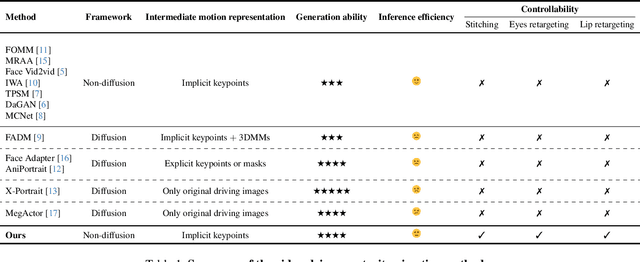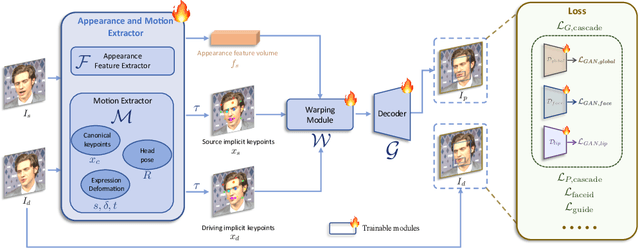Zhizhou Zhong
VISTA: Enhancing Vision-Text Alignment in MLLMs via Cross-Modal Mutual Information Maximization
May 19, 2025Abstract:Current multimodal large language models (MLLMs) face a critical challenge in modality alignment, often exhibiting a bias towards textual information at the expense of other modalities like vision. This paper conducts a systematic information-theoretic analysis of the widely used cross-entropy loss in MLLMs, uncovering its implicit alignment objective. Our theoretical investigation reveals that this implicit objective has inherent limitations, leading to a degradation of cross-modal alignment as text sequence length increases, thereby hindering effective multimodal information fusion. To overcome these drawbacks, we propose Vision-Text Alignment (VISTA), a novel approach guided by our theoretical insights. VISTA introduces an explicit alignment objective designed to maximize cross-modal mutual information, preventing the degradation of visual alignment. Notably, VISTA enhances the visual understanding capabilities of existing MLLMs without requiring any additional trainable modules or extra training data, making it both efficient and practical. Our method significantly outperforms baseline models across more than a dozen benchmark datasets, including VQAv2, MMStar, and MME, paving the way for new directions in MLLM modal alignment research.
Data Synthesis with Diverse Styles for Face Recognition via 3DMM-Guided Diffusion
Apr 01, 2025Abstract:Identity-preserving face synthesis aims to generate synthetic face images of virtual subjects that can substitute real-world data for training face recognition models. While prior arts strive to create images with consistent identities and diverse styles, they face a trade-off between them. Identifying their limitation of treating style variation as subject-agnostic and observing that real-world persons actually have distinct, subject-specific styles, this paper introduces MorphFace, a diffusion-based face generator. The generator learns fine-grained facial styles, e.g., shape, pose and expression, from the renderings of a 3D morphable model (3DMM). It also learns identities from an off-the-shelf recognition model. To create virtual faces, the generator is conditioned on novel identities of unlabeled synthetic faces, and novel styles that are statistically sampled from a real-world prior distribution. The sampling especially accounts for both intra-subject variation and subject distinctiveness. A context blending strategy is employed to enhance the generator's responsiveness to identity and style conditions. Extensive experiments show that MorphFace outperforms the best prior arts in face recognition efficacy.
From Visuals to Vocabulary: Establishing Equivalence Between Image and Text Token Through Autoregressive Pre-training in MLLMs
Feb 13, 2025Abstract:While MLLMs perform well on perceptual tasks, they lack precise multimodal alignment, limiting performance. To address this challenge, we propose Vision Dynamic Embedding-Guided Pretraining (VDEP), a hybrid autoregressive training paradigm for MLLMs. Utilizing dynamic embeddings from the MLP following the visual encoder, this approach supervises image hidden states and integrates image tokens into autoregressive training. Existing MLLMs primarily focused on recovering information from textual inputs, often neglecting the effective processing of image data. In contrast, the key improvement of this work is the reinterpretation of multimodal alignment as a process of recovering information from input data, with particular emphasis on reconstructing detailed visual features.The proposed method seamlessly integrates into standard models without architectural changes. Experiments on 13 benchmarks show VDEP outperforms baselines, surpassing existing methods.
Second FRCSyn-onGoing: Winning Solutions and Post-Challenge Analysis to Improve Face Recognition with Synthetic Data
Dec 02, 2024Abstract:Synthetic data is gaining increasing popularity for face recognition technologies, mainly due to the privacy concerns and challenges associated with obtaining real data, including diverse scenarios, quality, and demographic groups, among others. It also offers some advantages over real data, such as the large amount of data that can be generated or the ability to customize it to adapt to specific problem-solving needs. To effectively use such data, face recognition models should also be specifically designed to exploit synthetic data to its fullest potential. In order to promote the proposal of novel Generative AI methods and synthetic data, and investigate the application of synthetic data to better train face recognition systems, we introduce the 2nd FRCSyn-onGoing challenge, based on the 2nd Face Recognition Challenge in the Era of Synthetic Data (FRCSyn), originally launched at CVPR 2024. This is an ongoing challenge that provides researchers with an accessible platform to benchmark i) the proposal of novel Generative AI methods and synthetic data, and ii) novel face recognition systems that are specifically proposed to take advantage of synthetic data. We focus on exploring the use of synthetic data both individually and in combination with real data to solve current challenges in face recognition such as demographic bias, domain adaptation, and performance constraints in demanding situations, such as age disparities between training and testing, changes in the pose, or occlusions. Very interesting findings are obtained in this second edition, including a direct comparison with the first one, in which synthetic databases were restricted to DCFace and GANDiffFace.
LivePortrait: Efficient Portrait Animation with Stitching and Retargeting Control
Jul 03, 2024



Abstract:Portrait Animation aims to synthesize a lifelike video from a single source image, using it as an appearance reference, with motion (i.e., facial expressions and head pose) derived from a driving video, audio, text, or generation. Instead of following mainstream diffusion-based methods, we explore and extend the potential of the implicit-keypoint-based framework, which effectively balances computational efficiency and controllability. Building upon this, we develop a video-driven portrait animation framework named LivePortrait with a focus on better generalization, controllability, and efficiency for practical usage. To enhance the generation quality and generalization ability, we scale up the training data to about 69 million high-quality frames, adopt a mixed image-video training strategy, upgrade the network architecture, and design better motion transformation and optimization objectives. Additionally, we discover that compact implicit keypoints can effectively represent a kind of blendshapes and meticulously propose a stitching and two retargeting modules, which utilize a small MLP with negligible computational overhead, to enhance the controllability. Experimental results demonstrate the efficacy of our framework even compared to diffusion-based methods. The generation speed remarkably reaches 12.8ms on an RTX 4090 GPU with PyTorch. The inference code and models are available at https://github.com/KwaiVGI/LivePortrait
SlerpFace: Face Template Protection via Spherical Linear Interpolation
Jul 03, 2024



Abstract:Contemporary face recognition systems use feature templates extracted from face images to identify persons. To enhance privacy, face template protection techniques are widely employed to conceal sensitive identity and appearance information stored in the template. This paper identifies an emerging privacy attack form utilizing diffusion models that could nullify prior protection, referred to as inversion attacks. The attack can synthesize high-quality, identity-preserving face images from templates, revealing persons' appearance. Based on studies of the diffusion model's generative capability, this paper proposes a defense to deteriorate the attack, by rotating templates to a noise-like distribution. This is achieved efficiently by spherically and linearly interpolating templates, or slerp, on their located hypersphere. This paper further proposes to group-wisely divide and drop out templates' feature dimensions, to enhance the irreversibility of rotated templates. The division of groups and dropouts within each group are learned in a recognition-favored way. The proposed techniques are concretized as a novel face template protection technique, SlerpFace. Extensive experiments show that SlerpFace provides satisfactory recognition accuracy and comprehensive privacy protection against inversion and other attack forms, superior to prior arts.
Second Edition FRCSyn Challenge at CVPR 2024: Face Recognition Challenge in the Era of Synthetic Data
Apr 16, 2024



Abstract:Synthetic data is gaining increasing relevance for training machine learning models. This is mainly motivated due to several factors such as the lack of real data and intra-class variability, time and errors produced in manual labeling, and in some cases privacy concerns, among others. This paper presents an overview of the 2nd edition of the Face Recognition Challenge in the Era of Synthetic Data (FRCSyn) organized at CVPR 2024. FRCSyn aims to investigate the use of synthetic data in face recognition to address current technological limitations, including data privacy concerns, demographic biases, generalization to novel scenarios, and performance constraints in challenging situations such as aging, pose variations, and occlusions. Unlike the 1st edition, in which synthetic data from DCFace and GANDiffFace methods was only allowed to train face recognition systems, in this 2nd edition we propose new sub-tasks that allow participants to explore novel face generative methods. The outcomes of the 2nd FRCSyn Challenge, along with the proposed experimental protocol and benchmarking contribute significantly to the application of synthetic data to face recognition.
* arXiv admin note: text overlap with arXiv:2311.10476
Privacy-Preserving Face Recognition Using Trainable Feature Subtraction
Mar 19, 2024Abstract:The widespread adoption of face recognition has led to increasing privacy concerns, as unauthorized access to face images can expose sensitive personal information. This paper explores face image protection against viewing and recovery attacks. Inspired by image compression, we propose creating a visually uninformative face image through feature subtraction between an original face and its model-produced regeneration. Recognizable identity features within the image are encouraged by co-training a recognition model on its high-dimensional feature representation. To enhance privacy, the high-dimensional representation is crafted through random channel shuffling, resulting in randomized recognizable images devoid of attacker-leverageable texture details. We distill our methodologies into a novel privacy-preserving face recognition method, MinusFace. Experiments demonstrate its high recognition accuracy and effective privacy protection. Its code is available at https://github.com/Tencent/TFace.
 Add to Chrome
Add to Chrome Add to Firefox
Add to Firefox Add to Edge
Add to Edge